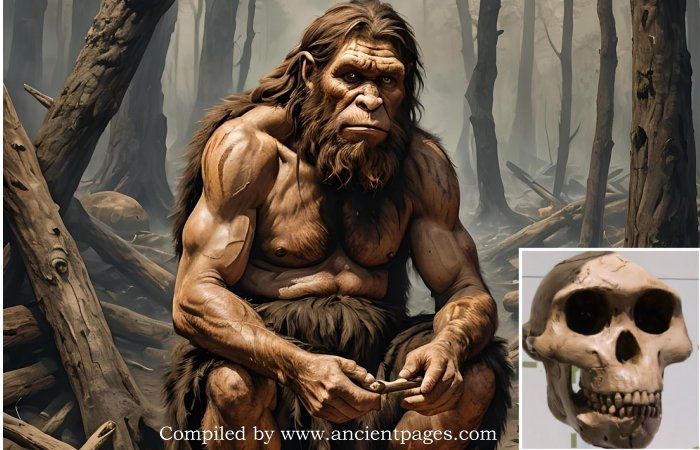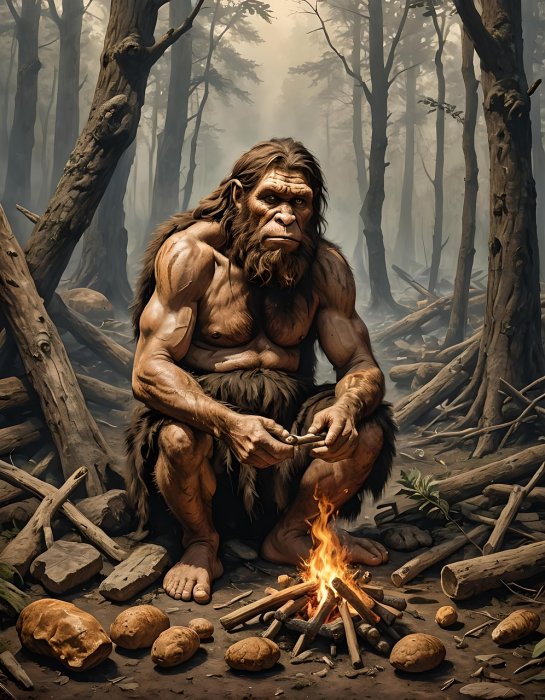Evolution Study Re-Writes History – Why Were Some Early Male Ancestors Significantly Larger Than Females?

Jan Bartek – AncientPages.com – A recent study has uncovered that males of some of our earliest ancestors were notably larger than their female counterparts.
This significant size difference observed in both Australopithecus afarensis, which includes the well-known fossil “Lucy,” and A. africanus, a related species from southern Africa, indicates that these ancient hominins might have lived in social structures characterized by intense male competition. This competition likely contributed to the marked size disparity between the sexes.
Credit: ArtSpark – Pixabay – Public Domain
The research, led by University at Albany anthropologist Adam D. Gordon, employed an innovative method to address the challenges posed by incomplete fossil records. The findings reveal that both A. afarensis and A. africanus exhibited greater sexual dimorphism than modern humans—and in some instances, even more so than gorillas—highlighting intriguing aspects of early human evolution and social behavior.
“These weren’t modest differences,” said Gordon, an associate professor in the College of Arts and Sciences. “In the case of A. afarensis, males were dramatically larger than females—possibly more so than in any living great ape.
“And although both of these extinct hominin species exhibited greater sex-specific size differences than modern humans do, they were also more different from each other in this respect than living ape species are, suggesting a greater diversity of evolutionary pressures acting on these closely related species than we had previously appreciated.”
The findings provide a deeper understanding of interpretations related to the fossil record. Previous research had produced varying conclusions regarding dimorphism in A. afarensis, with some studies indicating it was similar to the relatively low levels observed in modern humans. Additionally, direct comparisons between fossil species had not been conducted before due to limitations posed by incomplete fossil samples and inadequate statistical power, which hindered the detection of actual differences.
“This analysis overcomes these issues by using an iterative resampling method that mimics the missing data structure in both fossil species when sampling from skeletal material of living species, allowing the inclusion of multiple fossil individuals even when those individual specimens are fragmentary,” said Gordon.
“This study provides strong evidence that sex-specific evolutionary pressures—likely involving both male competition for mates and resource stress acting more intensely on female size due to the metabolic constraints of pregnancy and lactation—played a larger role in early hominin evolution than previously believed.”
Why sexual size dimorphism matters
Sexual size dimorphism (SSD) is more than just a physical characteristic; it provides insights into behavior and evolutionary strategies. According to sexual selection theory, high SSD in living primates often indicates significant male–male competition and social structures that support polygynous mating systems, where one or a few dominant males have reproductive access to multiple females. Conversely, low SSD can occur in any species but is commonly found in those with pair-bonded social structures and minimal competition for mating opportunities. In modern human populations, there is low to moderate SSD, with males generally being slightly larger than females on average but with considerable overlap in size between the sexes.
Furthermore, research by Gordon suggests that high SSD in living primates may also be linked to intense resource stress. In situations where food is scarce, smaller healthy females are able to meet their metabolic needs and store energy for reproduction more efficiently than larger females. This results in more offspring from smaller mothers over generations and leads to a greater difference in size between males and females.
The pronounced sexual size dimorphism (SSD) observed in both Australopithecus species indicates significant male competition, akin to what is seen in chimpanzees or even gorillas. The variation between the two fossil species might be attributed to differences in the intensity of sexual selection pressures and/or resource stress within their environments, such as varying lengths of dry seasons with limited fruit availability affecting female body size.
This notable SSD among these ancient hominins stands in stark contrast to the more balanced sizes found in modern humans. It provides insight into a distinct model of early hominin life, where larger male size likely played a crucial role in reproductive success due to competitive factors, while smaller female size may have been advantageous for energy conservation.
How the research was conducted
Fossil data are often incomplete, making it nearly impossible to determine the sex of ancient individuals. To address this challenge, Gordon employed a geometric mean method to estimate size using various skeletal elements like the humerus, femur, and tibia. He then utilized resampling techniques to simulate thousands of comparisons between fossil hominins and modern primates. This approach ensured that the statistical models accurately reflected the incomplete nature of real fossil samples.
Data from modern gorillas, chimpanzees, and humans with known sex and complete skeletons were used to create a comparative framework. Unlike previous studies that sometimes misinterpreted weak statistical results as evidence of similarity, Gordon’s methods identified clear differences even with relatively small fossil samples.
To eliminate the possibility that body size changes in A. afarensis were due to evolutionary trends rather than sex differences, Gordon examined fossils from the Hadar Formation in Ethiopia over a 300,000-year period for chronological trends. His analysis found no significant changes in size over time, suggesting that observed variations are best attributed to male-female differences rather than evolutionary drift or long-term size increases.
Rewriting history
Gordon’s findings have significant implications for our understanding of early human evolution. Australopithecus afarensis, which existed between 3.9 and 2.9 million years ago, is often considered either a direct ancestor of modern humans or closely related to one. The pronounced sexual dimorphism observed in this species suggests that early hominins might have lived in more hierarchical and competitive social structures than previously believed.
New research by UAlbany anthropologist Adam D. Gordon finds substantial sexual dimorphism in some of our early human ancestors. Credit: Ken Zirkel,the Museum of Natural History
In contrast, Australopithecus africanus, which coexisted with A. afarensis but appears slightly later in the fossil record—from about 3.3 to 2.1 million years ago—exhibited less sexual dimorphism. This could indicate that A. africanus represents a different evolutionary path on the hominin tree or perhaps marks a transitional phase toward more human-like social behaviors.
“We typically place these early hominins together in a single group called the gracile australopiths, a group of species that are thought to have interacted with their physical and social environments in very similar ways,” Gordon said.
“And while that’s true to a certain extent—the evidence suggests that both these species may have had social organizations more like gorillas than modern people—the significant difference in the amount of dimorphism in these two extinct species suggests that these closely related hominin species were subject to selection pressures more distinct than the selection pressures applied to any pair of similarly closely related living ape species, highlighting the diversity of ways that our extinct ancestors and close relatives interacted with the world.”
The study was published in the American Journal of Biological Anthropology
Written by Jan Bartek – AncientPages.com Staff Writer






